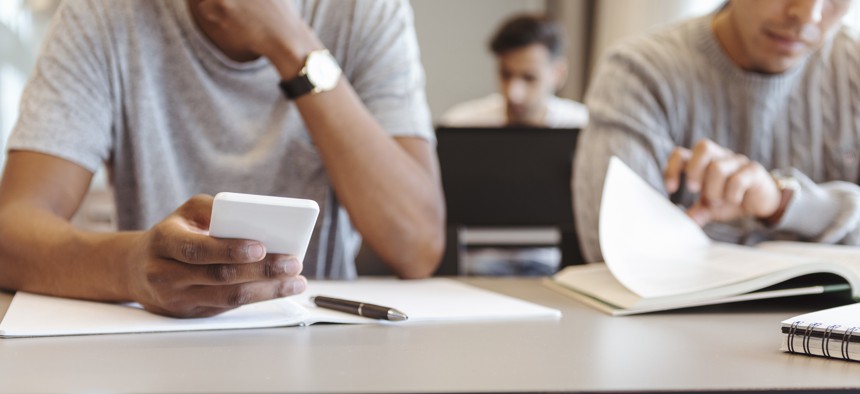Cell phone report offers policy ‘guidance,’ not mandates, for Maryland school systems

Kentaroo Tryman via Getty Images
One proposed requirement is for schools to implement a student telehealth policy by next school year.
This article was originally published by Maryland Matters.
A task force is offering Maryland schools statewide guidelines on student cell phone use during school hours, but is being careful to say local systems should have the flexibility to adopt policies to their own circumstances.
Those were among the recommendations from the Task Force on Cell Phone Use in Schools, whose report was discussed Tuesday by the Maryland State Board of Education. The report suggests broad parameters — saying, for example, that restrictions should be most-stringent in lower grades, becoming more liberal as students age — but leaves the details to the state’s 24 school systems.
“So, our task force really wanted to create a guidance document and not a requirement that districts adopt certain aspects of a policy,” said Hannah Oakley, deputy director of the board and one of two facilitators on the task force. “We wanted to empower our districts to create these policies and not [create] a statewide mandate.”
At the beginning of the 2024-25 school year, school systems in the state had a range of cell phone policies, the one constant being that cell phones should be turned off during instructional time.
Cell phone use drew the attention of state lawmakers, who introduced a total of six separate bills on the topic during this year’s General Assembly session, all of which would have required local school systems to have a cell phone policy in place.
All but one of the bills died in committee. The bill sponsored by Sen. Joanne C. Benson (D-Prince George’s) — which would have required the state Department of Education to develop guidelines for a policy “on student electronic devices during school hours” — made it to the House, which sent it back to the Senate with amendments on the last day of the legislative session, when time ran out on it.
The 17-member task force comprised of state officials, school superintendents, principals, teachers, parents and students did suggest a few requirements.
One would be for school districts to adopt a telehealth exception on cell phone use by middle and high school students with medical reasons that might require a phone, such as monitoring diabetes, or for those who have sensory or mental health needs. It recommended that those policies be in place in time for the 2025-26 school year.
In terms of student discipline, the task force said schools could follow a plan similar to one implemented in Montgomery County, which takes a graduated approach to responding to phone infractions.
The report also recommends school leaders could implement “phone-free initiatives,” incorporating a schoolwide campaign, for instance, for students to earn incentives by voluntarily turning off their phones and allowing school staff to put them away.
Cell phones as defined in the report would also include personal smart watches, headphones, laptops and tablets.
School board President Joshua Michael said he’s seeing young people wear Beats headphones “everywhere I go.”
The board took no action on the report Tuesday after a brief discussion. For the next step, Michael said the plan is for the board to turn any key recommendations into a resolution “that affirms the work of this report that we may consider as a board before moving into next school year.”





